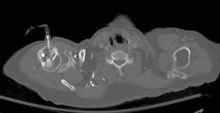Intraosseous infusion
[4] Because of Tocantins and O'Neill's success in their experiments with rabbits, human clinical trials were established using mainly the body of the sternum or the manubrium for access.
[6] Once Papper showed that the bone marrow space could be used with comparable success to administer IV fluids and drugs, intraosseous infusion was popularized during World War II to prevent soldiers' deaths via hemorrhagic shock.
When IV access is either not possible or delayed, other indications for utilizing the IO route include administering contrast if needed for radiology scans and drawing blood for laboratory testing and analysis.
[8] An IO infusion can be used on adult or pediatric populations when traditional methods of vascular access are difficult or otherwise cause unwanted delayed management of the administration of medications.
[3] The needle is inserted through the bone's hard cortex and into the soft marrow interior, which allows immediate access to the vascular system.
As of 2010, the American Heart Association no longer recommends using the endotracheal tube (ET) for resuscitation drugs, except as a last resort when IV or IO access cannot be gained.
IO administration is becoming more common in civilian and military pre-hospital emergency medical services (EMS) systems globally.
[14] Bone fracture complications can be decreased by using modern techniques and requiring more regular training in the methods of intraosseous marrow access for infusion.
The risk of developing compartment syndrome can be reduced by medical personnel checking the infusion site regularly for any signs of swelling.
Damage to the epiphyseal plate can be avoided by training medical personnel about proper landmarks to be used for determining puncture sites.
After proper education and training, medical professionals can obtain vascular access via the IO route of administration by using one of the multiple devices that have been approved by the FDA for 24-hour use.
[16] A comparison of intravenous (IV), intramuscular (IM), and intraosseous (IO) routes of administration concluded that the intraosseous (IO) route is the preferred method versus intramuscular (IM) and comparable to intravenous (IV) administration in delivering pediatric anaesthetic drugs.
Intraosseous infusion is used in instances such as, "immediate indication/life-threatening emergency, cardiac/respiratory arrest, acute shock, hypothermia, obesity, edema, thermal injury, etc.
[19] Similarly to adults, contraindications for IO infusion use in pediatrics include bone diseases such as osteogenesis imperfecta and osteopetrosis, and fractures.





